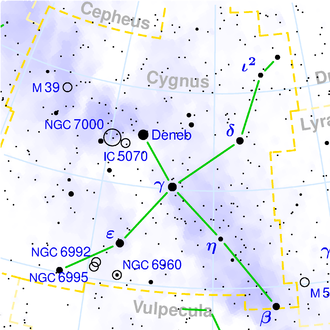Chi Cygni
|
Star χ Cygni |
|||||||||||||||
|---|---|---|---|---|---|---|---|---|---|---|---|---|---|---|---|
| χ Cyg is the star right at the arrowhead | |||||||||||||||
| AladinLite | |||||||||||||||
|
Observation dates equinox : J2000.0 , epoch : J2000.0 |
|||||||||||||||
| Constellation | swan | ||||||||||||||
| Right ascension | 19 h 50 m 33.92 s | ||||||||||||||
| declination | + 32 ° 54 ′ 50.6 ″ | ||||||||||||||
| Apparent brightness | 3.3 mag to 14.3 mag | ||||||||||||||
| Typing | |||||||||||||||
| B − V color index | +1.82 | ||||||||||||||
| U − B color index | +0.96 | ||||||||||||||
| R − I index | +2.68 | ||||||||||||||
| Spectral class | S6,2e to S10,4e | ||||||||||||||
| Variable star type | Mira changer | ||||||||||||||
| Astrometry | |||||||||||||||
| Radial velocity | (1.6 ± 0.6) km / s | ||||||||||||||
| parallax | (5.53 ± 1.10) mas | ||||||||||||||
| distance | (590 ± 120) ly (180 ± 40) pc |
||||||||||||||
| Proper movement | |||||||||||||||
| Rec. Share: | (−20.16 ± 0.73) mas / a | ||||||||||||||
| Dec. portion: | (−38.34 ± 0.90) mas / a | ||||||||||||||
| Physical Properties | |||||||||||||||
| Luminosity |
0.4 to 10,000 L ☉ |
||||||||||||||
| Effective temperature | 2490 K | ||||||||||||||
| Rotation time | 470 d | ||||||||||||||
|
Other names and catalog entries |
|||||||||||||||
|
|||||||||||||||
Chi Cygni (χ Cygni) is a variable star of the Mira type in the constellation Swan . Its variability was discovered in 1686 by Gottfried Kirch . It was thus the second discovered star of this variable class after Mira .
With an average period length of 408 days, Chi Cygni shows the greatest fluctuations in the apparent brightness of all mira stars . This reached extreme values of +3.3 mag and +14.3 mag. Thus, at a minimum, Chi Cygni is only visible with telescopes with an aperture (opening) of over 30 centimeters, while at the maximum it can often be seen with the naked eye.
The period from maximum to minimum is 241 days, from minimum to maximum 167 days.
Because CO and SiO, among other things, flow off as gases from the surface and surround the star as a cloud of molecules and silicate dust , there is an excess of color . H. the radiation from the star absorbed by the cloud is emitted again in the infrared spectral range. The infrared component of the radiation is therefore higher than would be expected for the temperature of the star according to Planck's law of radiation .
literature
- Robert Burnham Jr .: Burnham's Celestial Handbook, Volume 2. New York 1978
- R. Sauermost, Ed .: Lexicon of Astronomy , Spektrum Akademischer Verlag 1995
Web links
Individual evidence
- ↑ a b c Hipparcos catalog (ESA 1997)
- ↑ a b c Bright Star Catalog
- ↑ Pulkovo radial velocities for 35493 HIP stars
- ↑ a b c Hipparcos, the New Reduction (van Leeuwen, 2007)
- ↑ Chi Cyg . Federal German Working Group for Variable Stars V. Accessed February 8, 2019.
- ↑ Predicted Dates for Maximum and Minimum of Mira Stars on the BAAVSS program ( English ) The British Astronomical Association. Retrieved April 27, 2019.
